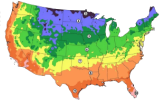Pakistan Mulberry Tree Information and Care
The Pakistan Mulberry tree, also sometimes referred to as toot afghan or Afghanistan Mulberries. Native to the region of both countries, this tree grows large and produces an abundance of fruit. These types of mulberries are not only different in shape from the Persian Mulberries, but they also taste differently. What sets the Pakistani Mulberries apart is their unique shape as they are long length wise. The fruit is narrow and can grow up to four inches long. The color is a dark shade of red similar to the color of blackberries. However, taste wise they are completely different as these mulberries are incredibly juicy and sweet.
The Pakistan Mulberry tree grows large and vigorously. However, prune to the desired height. Due to their strong root system, mulberry trees should be planted away from buildings or pipes as they can create structural damage. These resilient trees do very well in Southern California climate and produce an abundance of delicious fruit during the early Summer months.
In recent years the popularity of Pakistan Mulberries has risen considerably. In fact, they are now available at some of the Southern California farmers markets or select Persian markets. While the fruit is absolutely delicious eaten fresh, it has also become a popular and sought after pie-filling favorite. In addition, Pakistan Mulberries are also used to create delicious sauces and preserves.
Plant and grow Pakistani Mulberries in the full sun and in well-draining soil. Do not plant near building, walls, or sidewalks. Space about 15 -25 feet wide and tall. Water regularly until established. Discontinue water in the Winter while dormant. Harvest mulberries in the Summer. The fruit is ripe when color is reddish purple and juicy.
How to Fertilize a Mulberry Tree
Fertilize mulberry trees with manure and other organic fertilizers with higher phosphorus and potassium in the late Winter. Fertilizers like bone meal, humus, and flower and bloom fruit tree foods promote Spring blossoms and fruit production. Promote Springtime growth with nitrogen fertilizers such as blood meal.
Tips when Pruning Mulberry Trees
Trim in the Winter while dormant. Top the tips to reduce the height and encourage lower branches to grow. Remove any growth below the lowest main branches and the graft. Cut off dry twigs and growth going crossing towards the center. Do some thinning in the Summertime to direct the plant's energy. Remove excess fruits to help remaining fruit to develop larger.
Pest Management
Use an organic horticultural dormant spray like Neem oil in the Winter.
Spacing Between Trees:
- Standard-sized fruit trees typically require spacing of 20 to 25 feet between each tree.
- Semi-dwarf varieties may need spacing of 15 to 20 feet, while dwarf fruit trees can be spaced closer, around 10 to 15 feet apart.
- If planting multiple rows of fruit trees, maintain spacing between rows to allow for adequate sunlight penetration and airflow.
- Rows should typically be spaced 25 to 30 feet apart for standard-sized trees, and 15 to 20 feet apart for semi-dwarf and dwarf varieties.
- Consider the mature height and spread of the fruit trees when determining spacing.
- Ensure enough space between trees and other structures to accommodate their growth without crowding.
- Plant fruit trees in rows with the north to south orientation to maximize sunlight exposure on both sides of the trees.
- Avoid planting fruit trees too close to buildings, fences, or other structures, as their roots may cause damage over time.
- Prepare the planting area by loosening the soil and incorporating organic matter to improve drainage and fertility.
- Plant fruit trees at the same depth as they were in the nursery container, ensuring that the graft union (if present) is above the soil level.
Step One:
Soil and Planting: Plant in soil that drains well. Dig a hole that is as deep as the tree’s roots and at least twice as wide.
Step Two:
Place the tree in the hole and backfill around the plant’s roots with a mixture of the native soil and high-quality planting mix that has washed sand and organic fertilizer.
Step Three:
Create a basin around the roots drip zone so that water collects. Water deeply until the roots and nearby soil is saturated and reaches field capacity.
Full Sun Exposure:
- Most fruit trees thrive in full sun, which typically means they need at least 6 to 8 hours of direct sunlight each day.
- Choose a planting location that receives ample sunlight throughout the day, preferably in a spot with southern or western exposure.
- Sunlight is essential for photosynthesis, the process by which plants convert sunlight into energy to fuel growth and fruit production.
- Adequate sunlight promotes healthy leaf development, flowering, and fruit ripening in fruit trees.
- Avoid planting fruit trees in areas with excessive shade from buildings, tall trees, or other structures, as this can inhibit growth and reduce fruit production.
- Trees planted in shaded areas may produce fewer fruits, have slower growth rates, and be more susceptible to diseases and pests.
- Ensure that fruit trees are spaced appropriately to allow sunlight to reach all parts of the tree, including the canopy, branches, and fruiting spurs.
- Prune surrounding trees or shrubs that may shade fruit trees and obstruct sunlight.
- Monitor changes in sunlight exposure throughout the year, as seasonal variations in sun angle and tree foliage can affect light availability.
- Adjust planting locations or prune surrounding vegetation as needed to maintain optimal sunlight exposure for fruit trees.
Establishment Period:
- During the first year after planting, fruit trees require regular watering to establish strong root systems.
- Water newly planted fruit trees deeply and frequently, providing enough moisture to keep the soil consistently moist but not waterlogged.
- In general, fruit trees should be watered deeply once or twice a week, depending on soil type, weather conditions, and tree species.
- Adjust the frequency of watering based on rainfall, temperature, and soil moisture levels to prevent both under-watering and over-watering.
- Water fruit trees deeply to encourage deep root growth and drought tolerance.
- Apply water slowly and evenly to ensure that it penetrates the soil to a depth of at least 12 to 18 inches.
- Use drip irrigation, soaker hoses, or watering bags to deliver water directly to the root zone of fruit trees, minimizing water loss through evaporation and runoff.
- Avoid overhead watering, as it can promote fungal diseases and waste water by spraying foliage instead of reaching the root system.
- Water fruit trees in the early morning or late afternoon to reduce water loss through evaporation and minimize stress on the trees during the hottest part of the day.
- Avoid watering fruit trees during windy or extremely hot conditions, as water may evaporate quickly before it can be absorbed by the roots.
- Monitor soil moisture regularly by checking soil moisture levels with a moisture meter or by conducting a simple soil moisture test using your finger.
- Adjust watering practices based on soil moisture levels and weather conditions to ensure that fruit trees receive adequate moisture throughout the growing season.
- During periods of drought or prolonged dry spells, increase the frequency and duration of watering to prevent drought stress and maintain tree health.
- Consider applying a layer of mulch around the base of fruit trees to conserve soil moisture and reduce water loss through evaporation.
Timing of Fertilization:
- Fertilize fruit trees in early spring, just before new growth begins, to provide essential nutrients for the upcoming growing season.
- Avoid fertilizing fruit trees late in the growing season, as it may stimulate late-season growth that is susceptible to winter damage.
- Choose a balanced fertilizer specifically formulated for fruit trees, such as a 10-10-10 or 12-12-12 NPK (nitrogen, phosphorus, potassium) fertilizer.
- Consider using organic fertilizers, such as compost, aged manure, or organic fertilizer blends, to promote soil health and reduce the risk of chemical buildup.
- Apply fertilizer evenly around the base of the fruit tree, extending beyond the drip line of the branches.
- Avoid placing fertilizer directly against the trunk of the tree, as it may cause root burn or damage to the tree.
- Follow the recommended application rates provided on the fertilizer label or based on the specific needs of the fruit tree species and soil conditions.
- Use caution not to over-fertilize fruit trees, as excessive nitrogen can lead to excessive vegetative growth at the expense of fruit production.
- Water the fruit tree thoroughly after applying fertilizer to help dissolve and distribute the nutrients into the soil.
- Adequate moisture is essential to ensure that the roots can absorb the nutrients from the fertilizer effectively.
- For established fruit trees, fertilize once a year in early spring, unless soil tests indicate a specific nutrient deficiency that requires additional fertilization.
- Young or newly planted fruit trees may benefit from lighter, more frequent applications of fertilizer during the first few years to support growth and establishment.
- Periodically conduct soil tests to assess nutrient levels and pH balance, as well as to determine the specific fertilizer needs of fruit trees.
- Adjust fertilization practices based on soil test results to ensure that fruit trees receive the appropriate nutrients for optimal growth and fruit production.
Timing of Pruning:
- Prune fruit trees during the dormant season, typically in late winter to early spring before new growth begins.
- Avoid pruning fruit trees during periods of active growth or in late fall, as it may stimulate new growth that is vulnerable to winter damage.
- Use sharp, clean pruning tools, such as hand pruners, loppers, and pruning saws, to make clean cuts and minimize the risk of disease transmission.
- Disinfect pruning tools between each tree to prevent the spread of pathogens.
- Remove dead, diseased, or damaged branches to improve the overall health and appearance of the fruit tree.
- Thin out crowded or crossing branches to improve air circulation and sunlight penetration within the canopy.
- Shape the tree to promote an open, well-structured canopy that allows for even fruit production and easy harvesting.
- Begin by removing any dead, diseased, or broken branches, making clean cuts just outside the branch collar (the swollen area where the branch meets the trunk).
- Thin out excessive growth by selectively removing crowded or crossing branches to allow for better light and air distribution.
- Use heading cuts to prune back overly vigorous branches to encourage branching and promote fruiting wood formation.
- Consider the fruiting habit of the tree species when pruning, as some fruit trees produce fruit on spurs (short, stubby branches) while others bear fruit on new growth.
- Train young fruit trees by selectively pruning to establish a strong, well-balanced framework of scaffold branches.
- Encourage outward growth by pruning back inward-growing branches and removing competing leaders to maintain a central leader or open-center shape.
- Different fruit tree species may have specific pruning requirements based on their growth habits, fruiting patterns, and desired form.
- Research the specific pruning needs of the fruit tree species you are growing and tailor your pruning practices accordingly.
- Monitor the fruit tree throughout the growing season for any additional pruning needs, such as removing water sprouts or suckers that may develop.
- Regularly inspect the tree for signs of pests, diseases, or other issues that may require pruning intervention.
- Monitor for Pests:
- Regularly inspect fruit trees for signs of pest infestation, such as chewed leaves, distorted growth, or the presence of insects or larvae.
- Keep an eye out for common fruit tree pests, including aphids, scale insects, mites, caterpillars, and fruit flies.
- Cultural Practices:
- Maintain good cultural practices, such as proper pruning, watering, and fertilizing, to promote healthy, resilient fruit trees that are better able to withstand pest attacks.
- Remove and destroy any fallen fruit, leaves, or other plant debris that may harbor pests or disease pathogens.
- Natural Predators:
- Encourage natural predators of pests, such as ladybugs, lacewings, and predatory wasps, by providing habitat and avoiding the use of broad-spectrum pesticides that may harm beneficial insects.
- Plant flowering plants nearby to attract pollinators and beneficial insects that help control pest populations.
- Physical Barriers:
- Install physical barriers, such as tree wraps or trunk guards, to protect fruit trees from crawling pests like ants and rodents.
- Use floating row covers or netting to exclude flying insects, birds, and other pests from accessing fruit trees.
- Biological Control:
- Consider using biological control methods, such as releasing beneficial nematodes or predatory insects, to target specific pests while minimizing harm to non-target organisms.
- Introduce parasitic wasps, predatory mites, or other natural enemies of pest insects to help control populations without the need for chemical pesticides.
- Integrated Pest Management (IPM):
- Implement an integrated pest management (IPM) approach that combines multiple pest control strategies, including cultural, biological, physical, and chemical methods, to effectively manage pest populations while minimizing environmental impact.
- Monitor pest populations regularly and use thresholds to determine when intervention is necessary, prioritizing the use of non-chemical control methods whenever possible.
- Selective Pesticide Use:
- Use chemical pesticides as a last resort and only when non-chemical methods have proven ineffective or when pest populations exceed acceptable thresholds.
- Selectively choose pesticides that are least harmful to beneficial insects, pollinators, and the environment, and follow label instructions carefully to minimize risks to human health and the ecosystem.






